BEST HOMEWORK HELP AND TUTORING ,ALL KIND OF QUIZ or EXAM WITH GUARANTEE OF A.
Im an expert on major courses especially; psychology,Nursing, Human resource Management.Assisting students with quality work is my first priority. I ensure scholarly standards in my documents and i assure a GOOD GRADE if you will use my work.
- 1171
- 0
- 126
Community
- Followers
- Following
60 Reviews received
1356 items
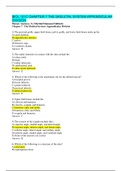
BIOL 121C CHAPTER 7 THE SKELETAL SYSTEM APPENDICULAR DIVISION | 100% CORRECT
BIOL 121C CHAPTER 7 THE SKELETAL SYSTEM APPENDICULAR DIVISION Human Anatomy, 7e (Martini/Timmons/Tallitsch) Chapter 7 The Skeletal System: Appendicular Division 1) The pectoral girdle, upper limb bones, pelvic girdle, and lower limb bones make up the A) axial skeleton. B) appendicular skeleton. C) pelvis. D) thoracic cage. E) vertebral column. 2) The radial structures in contact with the ulna include the A) ulnar notch. B) head. C) radial tuberosity. D) antebrachial joint. E) ...
- Exam (elaborations)
- • 9 pages •
BIOL 121C CHAPTER 7 THE SKELETAL SYSTEM APPENDICULAR DIVISION Human Anatomy, 7e (Martini/Timmons/Tallitsch) Chapter 7 The Skeletal System: Appendicular Division 1) The pectoral girdle, upper limb bones, pelvic girdle, and lower limb bones make up the A) axial skeleton. B) appendicular skeleton. C) pelvis. D) thoracic cage. E) vertebral column. 2) The radial structures in contact with the ulna include the A) ulnar notch. B) head. C) radial tuberosity. D) antebrachial joint. E) ...
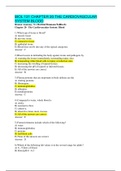
BIOL 121 CHAPTER 20 THE CARDIOVASCULAR SYSTEM BLOOD | VERIFIED SOLUTION
BIOL 121 CHAPTER 20 THE CARDIOVASCULAR SYSTEM BLOOD Human Anatomy, 7e (Martini/Timmons/Tallitsch) Chapter 20 The Cardiovascular System: Blood 1) What type of tissue is blood? A) muscle tissue B) nervous tissue C) connective tissue D) epithelial tissue E) Blood does not fit into any of the typical categories. 2) Blood assists in defending the body against toxins and pathogens by A) warming the tissues immediately surrounding injury sites. B) transporting white blood cells to injury o...
- Exam (elaborations)
- • 10 pages •
BIOL 121 CHAPTER 20 THE CARDIOVASCULAR SYSTEM BLOOD Human Anatomy, 7e (Martini/Timmons/Tallitsch) Chapter 20 The Cardiovascular System: Blood 1) What type of tissue is blood? A) muscle tissue B) nervous tissue C) connective tissue D) epithelial tissue E) Blood does not fit into any of the typical categories. 2) Blood assists in defending the body against toxins and pathogens by A) warming the tissues immediately surrounding injury sites. B) transporting white blood cells to injury o...
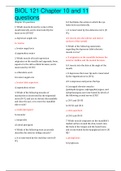
BIOL 121 Chapter 10 and 11 questions 100% CORRECT
Chapter 10 questions 1. Which muscle draws the corner of the mouth laterally, and is innervated by the facial nerve (N VII)? a. depressor anguli oris b. risorius c. levator anguli oris d. zygomaticus major 2. Which muscle of facial expression originates on the maxilla and zygomatic bone, superior to the infra-orbital foramen, and is innervated by CN VII? a. orbicularis oculi b. levator anguli oris c. levator labii superioris d. zygomaticus minor 3. Which of the following muscle...
- Exam (elaborations)
- • 8 pages •
Chapter 10 questions 1. Which muscle draws the corner of the mouth laterally, and is innervated by the facial nerve (N VII)? a. depressor anguli oris b. risorius c. levator anguli oris d. zygomaticus major 2. Which muscle of facial expression originates on the maxilla and zygomatic bone, superior to the infra-orbital foramen, and is innervated by CN VII? a. orbicularis oculi b. levator anguli oris c. levator labii superioris d. zygomaticus minor 3. Which of the following muscle...
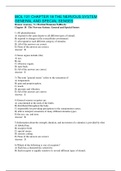
BIOL 121 CHAPTER 18 THE NERVOUS SYSTEM GENERAL AND SPECIAL SENSES
BIOL 121 CHAPTER 18 THE NERVOUS SYSTEM GENERAL AND SPECIAL SENSES Human Anatomy, 7e (Martini/Timmons/Tallitsch) Chapter 18 The Nervous System: General and Special Senses 1) All plasmalemmae A) respond to the same degree to all different types of stimuli. B) respond to changes in the extracellular environment. C) all respond to each different category of stimulus. D) All of the answers are correct. E) None of the answers are correct. 2) Sense organs include (the) A) eye. B) ear. C...
- Exam (elaborations)
- • 12 pages •
BIOL 121 CHAPTER 18 THE NERVOUS SYSTEM GENERAL AND SPECIAL SENSES Human Anatomy, 7e (Martini/Timmons/Tallitsch) Chapter 18 The Nervous System: General and Special Senses 1) All plasmalemmae A) respond to the same degree to all different types of stimuli. B) respond to changes in the extracellular environment. C) all respond to each different category of stimulus. D) All of the answers are correct. E) None of the answers are correct. 2) Sense organs include (the) A) eye. B) ear. C...
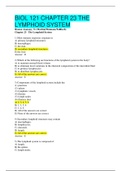
BIOL 121 CHAPTER 23 THE LYMPHOID SYSTEM | VERIFIED SOLUTION
BIOL 121 CHAPTER 23 THE LYMPHOID SYSTEM Human Anatomy, 7e (Martini/Timmons/Tallitsch) Chapter 23 The Lymphoid System 1) Most immune responses originate in A) primary lymphoid structures. B) macrophages. C) the skin. D) secondary lymphoid structures. E) the liver. 2) Which of the following are functions of the lymphoid system in the body? A) to maintain normal blood volume B) to eliminate local variations in the chemical composition of the interstitial fluid C) to produce lymphoc...
- Exam (elaborations)
- • 12 pages •
BIOL 121 CHAPTER 23 THE LYMPHOID SYSTEM Human Anatomy, 7e (Martini/Timmons/Tallitsch) Chapter 23 The Lymphoid System 1) Most immune responses originate in A) primary lymphoid structures. B) macrophages. C) the skin. D) secondary lymphoid structures. E) the liver. 2) Which of the following are functions of the lymphoid system in the body? A) to maintain normal blood volume B) to eliminate local variations in the chemical composition of the interstitial fluid C) to produce lymphoc...
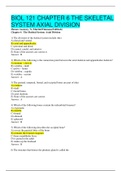
BIOL 121 CHAPTER 6 THE SKELETAL SYSTEM AXIAL DIVISION | VERIFIED SOLUTION
BIOL 121 CHAPTER 6 THE SKELETAL SYSTEM AXIAL DIVISION Human Anatomy, 7e (Martini/Timmons/Tallitsch) Chapter 6 The Skeletal System: Axial Division 1) The divisions of the skeletal system include (the) A) dorsal and ventral. B) axial and appendicular. C) proximal and distal. D) cranial, caudal, and anterior. E) None of the answers are correct.w 2) Which of the following is the connection point between the axial skeleton and appendicular skeleton? A) sternum - clavicle B) vertebra - ...
- Exam (elaborations)
- • 11 pages •
BIOL 121 CHAPTER 6 THE SKELETAL SYSTEM AXIAL DIVISION Human Anatomy, 7e (Martini/Timmons/Tallitsch) Chapter 6 The Skeletal System: Axial Division 1) The divisions of the skeletal system include (the) A) dorsal and ventral. B) axial and appendicular. C) proximal and distal. D) cranial, caudal, and anterior. E) None of the answers are correct.w 2) Which of the following is the connection point between the axial skeleton and appendicular skeleton? A) sternum - clavicle B) vertebra - ...
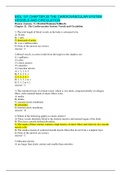
BIOL 121 CHAPTER 22 THE CARDIOVASCULAR SYSTEM VESSELS AND CIRCULATION
BIOL 121 CHAPTER 22 THE CARDIOVASCULAR SYSTEM VESSELS AND CIRCULATION Human Anatomy, 7e (Martini/Timmons/Tallitsch) Chapter 22 The Cardiovascular System: Vessels and Circulation 1) The total length of blood vessels in the body is estimated to be A) 30 feet. B) 1 mile. C) thousands of miles. D) over a million miles. E) None of the answers are correct. 2) Blood vessels, in correct order from the largest to the smallest, are: (1) capillaries (2) aorta (3) elastic arteries (4) ar...
- Exam (elaborations)
- • 12 pages •
BIOL 121 CHAPTER 22 THE CARDIOVASCULAR SYSTEM VESSELS AND CIRCULATION Human Anatomy, 7e (Martini/Timmons/Tallitsch) Chapter 22 The Cardiovascular System: Vessels and Circulation 1) The total length of blood vessels in the body is estimated to be A) 30 feet. B) 1 mile. C) thousands of miles. D) over a million miles. E) None of the answers are correct. 2) Blood vessels, in correct order from the largest to the smallest, are: (1) capillaries (2) aorta (3) elastic arteries (4) ar...
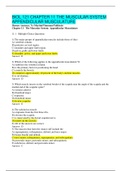
BIOL 121 CHAPTER 11 THE MUSCULAR SYSTEM APPENDICULAR MUSCULATURE
1) The major groups of appendicular muscles include those of (the) A) vertebral column. B) posterior cervical region. C) shoulder and upper limb region. D) pelvic girdle and lower limbs. E) shoulder, pelvis, and upper and lower limbs. 2) Which of the following applies to the appendicular musculature? It A) stabilizes the vertebral column. B) is the primary factor in positioning the head. C) controls the bowels. D) comprises approximately 40 percent of the body's skeletal muscles. ...
- Exam (elaborations)
- • 11 pages •
1) The major groups of appendicular muscles include those of (the) A) vertebral column. B) posterior cervical region. C) shoulder and upper limb region. D) pelvic girdle and lower limbs. E) shoulder, pelvis, and upper and lower limbs. 2) Which of the following applies to the appendicular musculature? It A) stabilizes the vertebral column. B) is the primary factor in positioning the head. C) controls the bowels. D) comprises approximately 40 percent of the body's skeletal muscles. ...
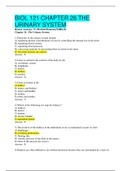
BIOL 121 CHAPTER 26 THE URINARY SYSTEM | VERIFIED SOLUTION
) Functions of the urinary system include A) regulating plasma concentrations of ions by controlling the amount lost in the urine. B) regulating blood volume. C) regulating blood pressure. D) conserving nutrients by preventing their excretion in the urine. Urine is carried to the exterior of the body by the A) circulatory system. B) lymphoids. C) ureters. D) urethra. E) urachus. Urine is formed in the A) kidney. B) kidney and bladder. C) ureter and bladder. D) urethra. E) ureter ...
- Exam (elaborations)
- • 10 pages •
) Functions of the urinary system include A) regulating plasma concentrations of ions by controlling the amount lost in the urine. B) regulating blood volume. C) regulating blood pressure. D) conserving nutrients by preventing their excretion in the urine. Urine is carried to the exterior of the body by the A) circulatory system. B) lymphoids. C) ureters. D) urethra. E) urachus. Urine is formed in the A) kidney. B) kidney and bladder. C) ureter and bladder. D) urethra. E) ureter ...
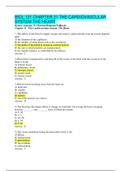
BIOL 121 CHAPTER 21 THE CARDIOVASCULAR SYSTEM THE HEART | GRADED A
BIOL 121 CHAPTER 21 THE CARDIOVASCULAR SYSTEM THE HEART Human Anatomy, 7e (Martini/Timmons/Tallitsch) Chapter 21 The Cardiovascular System: The Heart 1) The ability of the blood to supply oxygen and remove carbon dioxide from the tissues depends upon A) the diameter of the capillaries. B) the number of white blood cells in the circulation. C) the ability of the blood to remain in constant motion. D) the rate at which platelets are manufactured. E) the osmotic balance, as controlled by ...
- Exam (elaborations)
- • 11 pages •
BIOL 121 CHAPTER 21 THE CARDIOVASCULAR SYSTEM THE HEART Human Anatomy, 7e (Martini/Timmons/Tallitsch) Chapter 21 The Cardiovascular System: The Heart 1) The ability of the blood to supply oxygen and remove carbon dioxide from the tissues depends upon A) the diameter of the capillaries. B) the number of white blood cells in the circulation. C) the ability of the blood to remain in constant motion. D) the rate at which platelets are manufactured. E) the osmotic balance, as controlled by ...

NURS 451 EBP Change Process form(LATEST VERSION)
Primary Care 5e Dunphy (100% CORRECT ANSWERS)
ETHC 445 Week 8 Final Exam 1 with Answers | VERIFIED ANSWERS
NUR 254 FINAL EXAM QUESTIONS AND ANSWERS | VERIFIED SOLUTION
NR324 Exam 3 Study Guide(COMPLETE GUIDE)